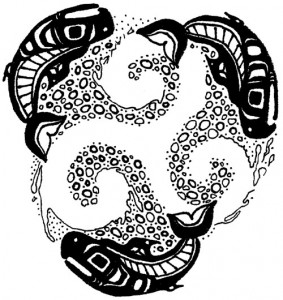
The Salmon Run at Maple Wood Creek, Illustration by Diane Wood
Jean, Devon, who is Jean’s grandson, and I, went to Maple Wood Creek in North Vancouver to see the Chum salmon return to the place where they were born after about five years in the Pacific Ocean. They came to lay eggs and to fertilize them in the loose gravel of Maple Wood Creek, and they came to die. Their deaths were part of the dance of Life which contains both birth and death. The salmon died, and yet they rise again.
Devon watched the salmon intently. “They’re wild,” he said. “They’re dying, but they go through the water like lightning.”
“Yes,” Jean said. “The intensity of their efforts to create a new generation of salmon is awesome. I don’t know how they can find Maple Wood Creek after spending five years in the ocean. They leave the fresh water creek as very small fry, and they return from the salt water sea as large fish weighing 10 pounds or so. Some people say that the salmon use the sun and stars as a guide, and others say the salmon can smell their home creek. I don’t know how they find their way home, but I’m thankful that they’re here.”
“I see, and smell, many dead salmon on the banks of Maple Wood Creek, and that saddens me,” I said, “but I, too, thank the salmon for their gift of new life. In the spring thousands upon thousands of small fry will make their way through the gravel and head out to sea.”
“Do you remember going to see the salmon when you were very young?” Jean asked Devon.
“I remember,” Devon replied. “I couldn’t say the word “fish”, so when I wanted to visit the salmon, I would make an “O” with my mouth the way the fish do. Then you would take me to Maple Wood Creek. I remember how the salmon would gather in a big bunch at the place where Maple Wood Creek runs into the Seymour River.”
“They were waiting for rain so there would be enough water in the creek for them to swim to their spawning grounds,” Jean said. “They didn’t have to wait for the rain this year.”
“Look there, the stream is so shallow that the salmon are half out of the water, but they just keep going,” Devon said.
“They’re going home,” I said, “and they have something to do so that the next generation might live. That reminds me of something the First Nations’ spiritual teacher, Black Elk, said. He said that we should live our lives so that the people might live.”
“I see a Chum digging a hole in the gravel with her tail. She’s getting ready to lay her eggs,” Jean said.
“Maybe we should move back,” Devon said. “They don’t like it when we get too close.” We moved back out of respect for the salmon, and we gave thanks to the Keepers of the Stream who had built rock fish ladders so that the salmon could swim up Maple Wood Creek more easily. “I thank all the people who understand that the life of the salmon and the life of human beings are connected. If we destroy the salmon, we are on our way to destroying ourselves,” I said.
“I agree,” Jean said. “Both the salmon and poor people are under threat from unrestrained greed. Caring for the salmon, and caring for people, is not simply a question of technology or another quick-fix program. It is a way of being in the world.”
“The salmon can teach us,” I said.
“The salmon dance in the water,” Devon said.
“We share this world together,” Jean said.
“Brother salmon, sister salmon,” I said. “We stand on sacred ground, here in the middle of the city. Life is richer at this place. We thank the salmon.”